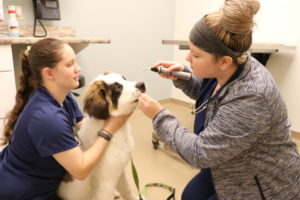Seizures
Seizures are the most common neurological problem in dogs and cats. To help understand what you can do to help, here is an overview including pathophysiology, testing, and treatment options that will be recommended if your pet develops seizure activity.
What is a seizure?
Neurons (brain cells) are inherently prone to becoming electrically “excited”. They form neuronal networks throughout the central nervous system (CNS) which transfer electrical information.
A seizure is the clinical manifestation of abnormal electrical activity in the neuronal networks of the cerebral cortex. When multiple local neurons in the brain display excessive electrical activity (a seizure focus), these neurons synchronize together to cause an epileptic seizure. An epileptic seizure can impact just one hemisphere of the brain (focal seizures) or spread to both cerebral hemispheres (generalized seizures). Typically, a patient is defined as having epilepsy when they have at least 2 unprovoked epileptic seizures more than 24 hours apart.
What causes epileptic seizures?
The term epileptic seizure can be categorized based on suspected etiology (cause):Idiopathic epilepsy is a disease with a genetic (or suspected genetic) cause. Genetic mutations can cause changes to the structure of neurons on the molecular or physical level, which will predispose them to inappropriately becoming hyperexcited. There are some dog breeds this has been documented in, some in which it is strongly suspected, and some in which we have been unable to find a cause.
Structural/metabolic epilepsy is the manifestation of seizures caused by a known abnormality in the body structure or chemistry. Structural brain lesions include tumors (cancer), inflammatory disease (meningitis), trauma, strokes, hydrocephalus, and more. Metabolic causes refer to chemical changes in the body that predispose to epilepsy including liver disease, hypoglycemia, electrolyte abnormalities, and toxins.
What does a seizure look like?
Seizures can cause a diverse range of signs in dogs and cats, just like in humans. Seizures often occur at night when an animal is resting or sleeping. The length of the seizure can range from seconds to minutes. The seizure event may be preceded by a prodrome – a behavior that can warn the owner a seizure is about to happen. This can include restlessness, attention-seeking, aggression, etc. A post-ictal phase can happen after the seizure, lasting from minutes to hours. Dogs in a post-ictal phase can appear blind, confused, restless, or aggressive to their owners and other animals. The ictal phase is defined by physical signs seen during the actual seizure episode:
Focal seizures are characterized by lateralized signs. This can include one-sided facial twitching, blinking, head jerking, hypersalivating (drooling), etc. Dogs and cats with focal seizures will not always lose consciousness.
Generalized seizures are characterized by involvement of the entire body. This includes falling to one side, hypersalivation, unconsciousness, dilated pupils, urination/defecation, and tonic (rigid muscle) or clonic (jerking) movements.
What testing should be done if a dog or cat has seizures?
If your pet has seizures, they should be seen by a veterinarian. There are multiple tests that will be recommended to try to figure out the cause.
The first step is physical examination and bloodwork (CBC, chemistry, bile acid panel, etc.). Bloodwork should be performed to look for the metabolic causes discussed above, as those require specific treatment which will often improve and/or resolve the seizures. A physical and neurological examination should be performed, especially to assess the cardiovascular and nervous systems, respectively.
If you have ruled out a metabolic cause for seizures, referral to a neurologist can be pursued. A veterinary neurologist focuses on treatment of disease in the brain and spinal cord. They may discuss performing a brain MRI and cerebral spinal fluid (CSF) analysis to rule out structural causes of seizures. Idiopathic epilepsy is a diagnosis of exclusion, therefore in pets with this condition all testing is normal.
What is the treatment for epilepsy?
Starting anti-epileptic medications is recommended if your pet has consistent seizures. It is uncommon for medication to stop seizures from occurring altogether; the goal of therapy is to decrease the number and severity of seizures. Pets on anti-epileptic medications require lifelong bloodwork monitoring. The selection of drugs used will depend on multiple factors including your pet’s systemic health, size, and suspected cause of seizures.
Dr. Amanda Landry, DVM
Diplomate, American College of Veterinary Internal Medicine (Neurology)
